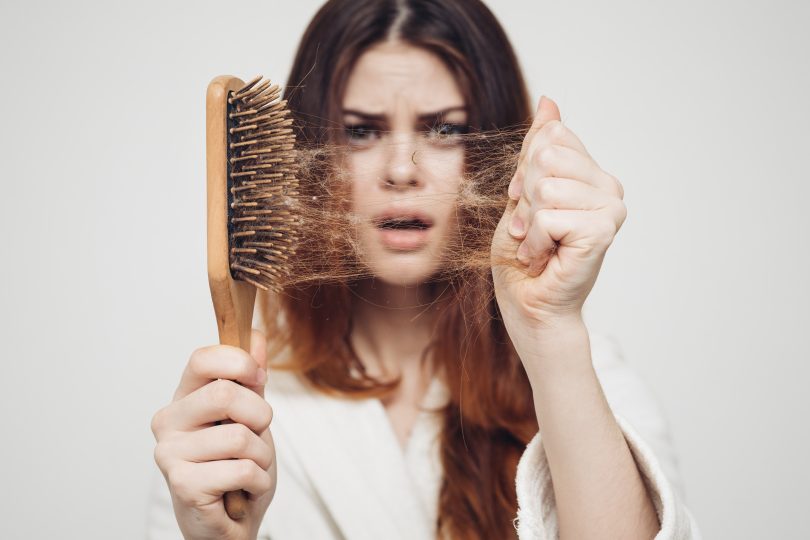We all probably ask ourselves the same question every time that we find clumps of hair in the hairbrush, is it just the normal hair shedding or is it something more serious?
We normally shed between 50 to 100 hair strands per day as a part of a healthy hair life cycle, though this average can vary a little on each person. Exceeding this average -which means that you find A LOT of hair in your drain, hairbrush and pillow- could mean that you are indeed suffering some sort of alteration, but don’t panic yet! The first step before finding a solution is to determine what kind of problem we are facing.
HAIR LIFE CYCLE
Hair life cycle is divided into 3 phases.
-
Anagen:
This is the active growth phase of the hair which lasts from 2 to 6 years. During this stage the hair grows around 1 cm per month. Most of our hair -around 90%- is in this stage.
-
Catagen:
It is a short transition stage that lasts 2-3 weeks. The hair stops growing during this phase and the root shrinks.
-
Telogen:
This is the last stage. The hair is completely inactive but remains around 100 days anchored in the scalp before falling out. Around 6-8% of our hair may be in this stage.
After the hair sheds, a new dermal papilla will appear and restart the cycle into a new hair strand. The dermal papilla in the hair follicle receives the nutrients and oxygen from the blood flow to feed the hair strand.
According to this, any alteration that shortens the duration of the hair life cycle (as shortening the anagen phase for instance), or that impedes the formation of new hairs may be considered a type of hair loss.
Regarding seasonal shedding, some recent studies claim that we probably shed more hair after summer -which may explain why we feel that we shed more hair in autumn- as we need more hair during the hot season to protect our scalp from sun damage. These theories, however, are not firmly recognized yet. On the other hand, some experts believe that is the stress that we normally suffer after the summer break what make us shed more hair in autumn.
MOST COMMON TYPES OF HAIR LOSS
ANDROGENIC ALOPECIA (AGA)
Is the most common type of alopecia. It affects more than the half of the population by the age of 50 though men tend to suffer it more and more severely than women. Androgenic alopecia is triggered by genetic (hereditary) factors and the conversion of testosterone into dihydrotestosterone (DHT) which miniaturizes the hair follicle during the anagen stage leading to the shortening of this phase and hindering the growth of new hair. Despite androgenic alopecia can affect both genders the hair loss pattern is different for men and women:
-
MALE-PATTERN HAIR LOSS:
Noticeable hair loss that starts at the temples and at the crown of the head.
-
FEMALE-PATTERN HAIR LOSS:
Increase of hair shedding, noticeable hair thinning and loss of volume.
TELOGEN EFFLUVIUM
This is the second most common cause of hair loss. Is usually temporary (but be careful as it can turn chronic) and occurs when the hair enters the telogen phase too soon, therefore shortening the hair life cycle.
Symptoms:
- Hair thinning
- Excessive hair shedding
It is normally triggered by stress, emotional problems, hormonal alterations (thyroids, pregnancy, etc), eating disorders, illness or drugs consumption, and is noticeable after approximately 3 months from the triggering event. It is usually self-corrected once the alteration that caused it disappears.
ALOPECIA AREATA (AA)
It is an autoimmune skin disease in which the immune system attacks the hair follicle interrupting the anagen phase. It can affect both genders, often at young age (under 30), but is more frequent in boys/men. It can be cured with appropriate treatment.
Symptoms:
- Bald patches in localized areas.
ANAGEN EFFLUVIUM
The hair sheds during the anagen phase due to an alteration in the hair follicle. It is mainly associated to people submitted to radiation or chemotherapy, but many other factors can trigger it: inflammatory diseases, alopecia areata, toxic chemicals, drugs, etc.
The symptoms are:
- Abrupt hair loss
When caused by Chemotherapy, hair normally regrows 1-3 months after the end of the treatment





